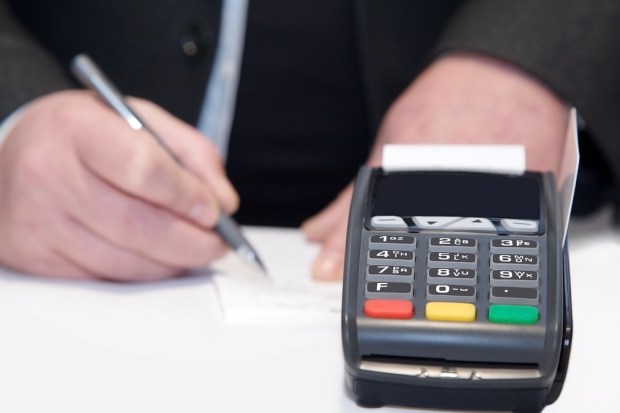Mastercard’s Kirkpatrick: So Long, Farewell To Signature At The POS

Tomorrow, April 13, signing a receipt at the end of a Mastercard credit or debit transaction at the physical POS will become a relic of payments history. Mastercard first announced its plan to go sans signature six months ago.
It’s a change that’s long overdue for many consumers.
Consumers like Karen Webster, who – in a conversation with Mastercard U.S. market development EVP Linda Kirkpatrick – shared a coffee shop anecdote about waiting in line behind someone who whipped out her debit card to pay for a $2.30 transaction … and had to sign.
“I mean, it could have been slower,” Webster remarked, “but it would have required paying her check in pennies.”
Kirkpatrick agreed rather wholeheartedly, noting that Webster was far from the only person who feels that way. As it turns out, there is no love lost for the signature at the POS.
In any given year, she noted, Mastercard announces a variety of changes, initiatives and adjustments to policy. They hear a lot, and often, from their issuer and merchant partners – which makes sense, given their B2B orientation – but generally don’t hear as much from consumers directly.
This change, she noted, was very much the exception.
“We don’t normally see an influx of consumer feedback directly,” Kirkpatrick said, “but this time, we got a massive wave of tweets and Instagram posts on people celebrating the end of the signature. We really had no idea people were so passionate about getting rid of it.”
How Has It Held on So Long?
That extra few seconds at the end of a transaction has long been an annoyance, Kirkpatrick said – but for a while, it was one with a purpose. In a pre-EMV world, she noted, there were chargeback codes that actually relied on having signatures on a merchant receipt in the event of a dispute.
Although those codes were rarely used, they had a definite purpose in a small range of cases when there was a dispute between the merchant and the issuer that needed to be arbitrated by the card network. And because there was a defined (if rare) use case, and because the inconvenience of having a customer sign a slip was basically small for everyone involved, it made sense to have customers sign for transactions, regardless.
As Kirkpatrick said, there were exceptions, namely at the behest of the QSR community. Requiring a signature for the large volume of low-dollar transactions slowed things down, so the rules were changed to waive them for purchases under $25.
“The QSRs are really advanced in the no signature path,” she noted – and it’s the market segment that’s most looking forward to Mastercard’s full shutdown on Friday.
And, Kirkpatrick pointed out, as retail has evolved and EMV has become the ruling standard in the U.S. market over the last two-and-a-half years – along with the advance of various digital payments technologies, like tokenization – the signature has lived past its purpose, from Mastercard’s point of view.
“There is no scenario in an EMV environment where a signature can rectify a chargeback. We are just at an inflection point that has been brought on by all of the advances of the last few years, where we have things like biometrics and tokens that have just fully eclipsed the signature,” Kirkpatrick observed.
Hitting the ‘Off Switch’
So, without a use case, Kirkpatrick noted, all there is left with the signature is the annoying friction that it can impose on consumers and merchants.
On the customer side of things, that means moving beyond something that has clearly become as outdated as a paper check.
According to a “Signature Retirement” survey Mastercard commissioned in honor of the grand closing of signing on a transaction, signatures are already moving into the rearview mirror for a majority of Americans – about 20 percent can’t even remember the last time they signed for a purchase.
“Even now, and without the wholesale waiving of the signature requirement, 80 percent of purchases are already eligible to be signature-free,” Kirkpatrick told Webster.
But when they do hit a signature requirement, they don’t like it at all. About 71 percent get annoyed if the person in line ahead of them has to stop and sign on a small transaction. Millennials particularly don’t like being asked to sign for things, since they really, really don’t like writing in cursive.
On the merchant side, she noted, it’s about giving retailers of all descriptions the ability to offer and checkout transaction flow that makes sense given the specific needs of their business.
Some retailers, she noted, might actually hold onto the signature phase of the purchase for reasons outside of the chargeback process, which Kirkpatrick said is perfectly fine. There are circumstances, she observed, where certain merchants – particularly with jewelry stores and electronics vendors – want to be able to put their own security protocols in place.
As for the consumers, who raved so cheerfully in October at the news that the signatures were going away for good, Karen Webster asked, will they notice that they’ve suddenly almost all gone by the wayside?
Hard to say, Kirkpatrick noted, since consumers don’t always notice a good experience with the same consistency as they notice the bad ones. They might just go on with their commerce lives, blissfully unaware of the improvement on a conscious level. They probably won’t even say “thank you.”
But if it drives them to transact more, or build bigger baskets because subconsciously they know they won’t have a little roadblock to jump over at the end – well, that’s an excellent thank-you as far as Mastercard’s issuers and merchants are concerned.
